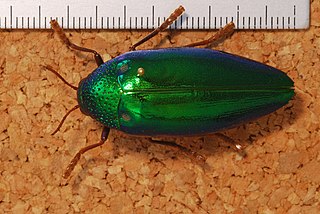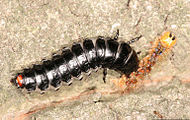
Lymantria dispar, also known as the gypsy moth or the spongy moth, is a species of moth in the family Erebidae native to Europe and Asia. Lymantria dispar is subdivided into several subspecies, with subspecies such as L. d. dispar and L. d. japonica being clearly identifiable without ambiguity. Lymantria dispar has been introduced to several continents and is now additionally found as an invasive species in Africa, North America and South America. The polyphagous larvae live on a variety of deciduous and coniferous trees and can cause severe damage in years of mass reproduction. Due to these features, Lymantria dispar is listed among the world's 100 worst invasive alien species.

Ground beetles are a large, cosmopolitan family of beetles, the Carabidae, with more than 40,000 species worldwide, around 2,000 of which are found in North America and 2,700 in Europe. As of 2015, it is one of the 10 most species-rich animal families. They belong to the Adephaga. Members of the family are primarily carnivorous, but some members are herbivorous or omnivorous.

The pine processionary is a moth of the subfamily Thaumetopoeinae in the family Notodontidae, known for the irritating hairs of its caterpillars, their processions, and the economic damage they cause in coniferous forests. The species was first described scientifically by Michael Denis and Ignaz Schiffermüller in 1775, though it was known to the ancients, with remedies described by Theophrastus, Dioscorides and Pliny the Elder. Its processionary behaviour was described in 1916 by the French entomologist Jean-Henri Fabre. It is one of the most destructive species to pines and cedars in Central Asia, North Africa and southern Europe.

Calosoma is a genus of large ground beetles that occur primarily throughout the Northern Hemisphere, and are referred to as caterpillar hunters or caterpillar searchers. Many of the 167 species are largely or entirely black, but some have bright metallic coloration. They produce a foul-smelling spray from glands near the tip of the abdomen. They are recognizable due to their large thorax, which is almost the size of their abdomen and much wider than their head.

Glyptapanteles is a genus of endoparasitoid wasps found in all continents, except Antarctica. The larvae of Glyptapanteles species are able to manipulate their hosts into serving as bodyguards.

Tachina fera is a species of fly in the genus Tachina of the family Tachinidae. It was first described by Carl Linnaeus in 1761.

Heterorhina elegans is a species of Scarab beetle found in India and Sri Lanka that belongs to the flower chafer subfamily. Its genus name is frequently misspelled as "Heterorrhina". The adults are about 2 to 3 cm long and are usually bright glassy green appearing reddish at some angles. The clypeus is narrow and there is a ridge along the middle. They are seen in aggregations made up of large numbers in southern India during June to October.

The gypsy moth, also known as the spongy moth, was introduced in 1868 into the United States by Étienne Léopold Trouvelot, a French scientist living in Medford, Massachusetts. Because native silk-spinning caterpillars were susceptible to disease, Trouvelot imported the species in order to breed a more resistant hybrid species. Some of the moths escaped, found suitable habitat, and began breeding. The gypsy moth is now a major pest of hardwood trees in the Eastern United States.

Chrysanthia viridissima is a species of beetles belonging to the family Oedemeridae subfamily Nacerdinae.

Compsilura concinnata is a parasitoid native to Europe that was introduced to North America in 1906 to control the population of an exotic forest, univoltine, spongy moth named Lymantria dispar. It is an endoparasitoid of larvae and lives with its host for most of its life. Eventually the parasitoid ends up killing the host and occasionally eating it. It attacks over 200 host species, mainly insects from the Orders: Coleoptera, Lepidoptera and Hymenoptera. Since this parasite has the ability to attack many different types of hosts, the organism has spilled over from the intended forest systems into other areas, like agricultural fields, affecting cabbage pests including the cabbage looper (Trichoplusia); the cabbage worm ; and even other invasive species such as the brown-tail moth. However, it also attacks native, non-pest insects such as the Cecropia moth and American moon moth.

Calosoma retusum is a beetle of the family Carabidae.

Sternocera aequisignata is a species of jewel beetles belonging to the subfamily Julodinae. Its bright metallic green elytra are frequently used in jewellery making.

Calosoma calidum is a species of ground beetle in the subfamily of Carabinae. It was described by Johan Christian Fabricius in 1775. It occurs throughout Canada and the northern and eastern parts of the United States. About 19mm to 27mm long, this beetle is black with rows of red or gold spots or pits on its elytra. It can be found in fields and disturbed habitats. Larvae and adults prey upon moth caterpillars.

Calosoma frigidum, also known as the cold-country caterpillar hunter, is a species of ground beetle in the subfamily Carabinae. It was first described by William Kirby in 1837. Occurring throughout southern Canada and the United States, it is about 16mm to 27mm long and black, with rows of pits or dots along its elytra. These pits are an iridescent blue/green, and larger than the pits of many other Calosoma species. It can be found in wooded areas and is active at night, while hiding under debris by day.

Calosoma sayi, also known as "Say's caterpillar hunter or "Black Caterpillar Hunter", is a species of ground beetle of the subfamily Carabinae. It was described by Pierre François Marie Auguste Dejean in 1826. A large, lustrous black beetle found throughout the United States, its habitat is fields and disturbed areas. About 25mm to 28mm long, its grooved elytra have rows of metallic dots or pits. Said pits are smaller than many Calosoma, and are ruby red. Both larvae and adults prey upon other larvae and pupae, specifically those of grubs, flies, and lepidoptera.

Lymantria dispar asiatica, the LDA moth or Asian spongy moth, also known as the Asian gypsy moth, is a moth in the family Erebidae of Eurasian origin. It is similar to Lymantria dispar dispar in appearance, but adult females can fly. It is classified as a pest and is host to over 500 species of trees, shrubs and plants.

Lymantria dispar dispar, commonly known as the gypsy moth, European gypsy moth, LDD moth, or North American gypsy moth or spongy moth, is a species of moth in the family Erebidae. It has a native range that extends over Europe and parts of Africa, and is an invasive species in North America.

Lymantria dispar japonica, also known as the Japanese gypsy moth, is a moth in the family Erebidae of Eurasian origin.
Lymantria dispar multicapsid nuclear polyhedrosis virus or LdMNPV is a viral infection in spongy moths that causes infected larvae to die and disintegrate. Infected larvae climb to the top of a tree and die. The larvae then melt or disintegrate, falling onto the foliage below, where they infect more larvae.

Sternocera ruficornis is a species of beetle belonging to the Buprestidae family. Its bright metallic green elytra are frequently used in jewellery making.
























